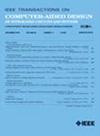DRAM垂直通道阵列晶体管的三维线边缘粗糙度研究
IF 2.9
3区 计算机科学
Q2 COMPUTER SCIENCE, HARDWARE & ARCHITECTURE
IEEE Transactions on Computer-Aided Design of Integrated Circuits and Systems
Pub Date : 2025-02-25
DOI:10.1109/TCAD.2025.3546195
引用次数: 0
摘要
线边缘粗糙度(LER)是半导体制造过程中出现的一种不良现象,会引起半导体器件特性的波动,并可能导致显着的良率下降。因此,在制造集成电路之前必须仔细考虑LER。在这项研究中,我们提出了一种在具有门全能(GAA)结构的垂直通道阵列晶体管(VCATs)中实现和分析动态随机存取存储器应用的方法。首先,我们提出了一种在GAA半导体器件中可靠实现LER的方法。接下来,我们将该方法扩展到更复杂的结构,超出基本的圆柱形GAA结构。利用所提出的方法,我们通过检查直流性能指标,如IOFF、IDS、LIN、IDS、SAT、VT、LIN、VT、SAT、IOV、LIN和IOV、SAT,来研究LER对各种VCAT设备配置的影响。此外,我们通过混合模式模拟探索交流性能指标(THOLD, TREAD和TWRITE)。结果表明,影响ler诱导的VCATs波动的参数随晶体管的工作区域(即晶体管是否导通)而变化。本文章由计算机程序翻译,如有差异,请以英文原文为准。
Study of 3-D Line Edge Roughness (LER) in Vertical Channel Array Transistor for DRAM
Line edge roughness (LER) is an undesirable phenomenon that arises during semiconductor fabrication processes, causing fluctuations in the characteristics of semiconductor devices and potentially leading to significant yield degradation. Consequently, LER must be meticulously considered before fabricating integrated circuits. In this study, we present an approach for implementing and analyzing LER in vertical channel array transistors (VCATs) with a gate-all-around (GAA) structure for dynamic random access memory applications. Initially, we propose a method for reliably implementing LER in GAA semiconductor devices. Next, we extend the method to more complex structures beyond the basic cylindrical GAA structure. Utilizing the proposed method, we investigate the impact of LER on various VCAT device configurations by examining DC performance metrics such as IOFF, IDS,LIN, IDS,SAT, VT,LIN, VT,SAT, IOV,LIN, and IOV,SAT. Additionally, we explore AC performance metrics (THOLD, TREAD, and TWRITE) through mixed-mode simulations. The results show that the parameters influencing LER-induced fluctuations in VCATs vary depending on the transistor’s operating region (i.e., whether the transistor is turned on or not).
求助全文
通过发布文献求助,成功后即可免费获取论文全文。
去求助
来源期刊
CiteScore
5.60
自引率
13.80%
发文量
500
审稿时长
7 months
期刊介绍:
The purpose of this Transactions is to publish papers of interest to individuals in the area of computer-aided design of integrated circuits and systems composed of analog, digital, mixed-signal, optical, or microwave components. The aids include methods, models, algorithms, and man-machine interfaces for system-level, physical and logical design including: planning, synthesis, partitioning, modeling, simulation, layout, verification, testing, hardware-software co-design and documentation of integrated circuit and system designs of all complexities. Design tools and techniques for evaluating and designing integrated circuits and systems for metrics such as performance, power, reliability, testability, and security are a focus.

 求助内容:
求助内容: 应助结果提醒方式:
应助结果提醒方式:


